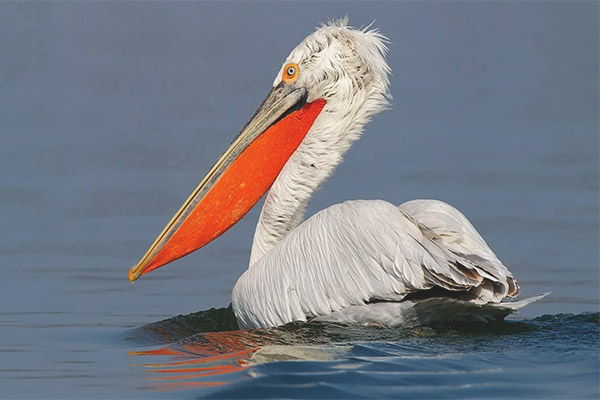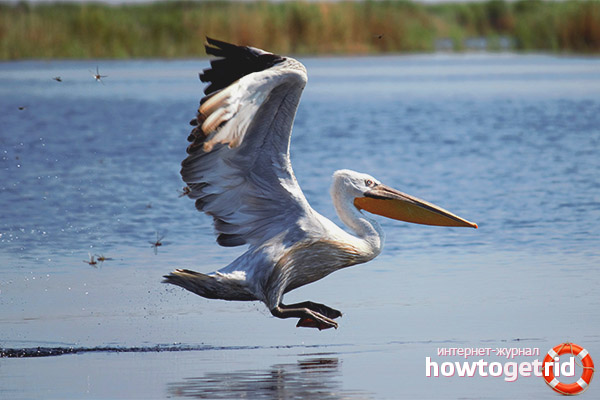The content of the article
The curly pelican is a migratory nesting bird of the pelican family. It is very similar to the pink pelican except for its size - curly larger. A distinctive feature of the birds are curly feathers on the crown and back of the neck. The peculiar hairstyle, large beak and the portly size of a clumsy body caused the second name of the bird - Baba. However, birds of this species feel uncomfortable only on land, but they simply have no equal in the air and on the water.
Appearance of curly pelican
The length of the body of large individuals of the male reaches almost two meters. Wingspan 3-3.5 meters. The beak of a pelican is very long, reaching half a meter. The average bird size is 10-12 kg, in some cases it can reach up to a dozen kilograms.Long curly feathers on the head and the back of the head form a peculiar mane or hairstyle, which favorably emphasizes the elegance of the individual. The throat pouch has a bright orange color, and during the nesting period it becomes reddish. Paws of dark gray color, almost black. By the number of curly hairs on the back of his head and teme it is possible to judge the age of the pelican - the older the bird, the more "curly" her hair.
Habitat
Curly Pelican Migration
Curly pelicans - migratory birds, which in Russian latitudes in the winter almost can not be found.For wintering birds are sent in rather large flocks, three hundred individuals and even more. Quite often, flocks of mixed, that is, curly pelicans fly side by side with the classic pink brethren. In the migratory flock, the birds try to keep close enough to each other, but the pelicans reach the nesting site in small groups, in pairs, and even alone. In the spring the curly pelican returns home among the first birds. Depending on the weather and territory, the first pelicans can be found already at the end of February and the beginning of March. Birds fly away for wintering too late enough. In some cases, if the winter in the region is not very severe and large water bodies do not freeze completely, then pelicans remain. However, in our country this happens quite rarely, only isolated cases.
Reproduction and nesting of the curly pelican

Pelicans reach sexual maturity in the third year of life, from the very moment of arrival the birds keep in pairs, which makes it possible to assume that pelicans are monogamous. As a rule, nesting occurs in small groups, 5-10 pairs.Sometimes curly pelicans nest in large flocks along with other cormorant birds and pink pelicans. However, in this case, individuals try to keep along the edge of the main group, as if isolating their tribal affiliation.
The mating games of the curly pelican are very interesting, the male tries in every way to gain the attention of the desired lady (if the couple has not yet been formed). The young gentleman walks around the female, approaching her and moving away from her. He flaps his wings, rubs his neck against a female, cleans its wings with its beak, that is, “cares” in every possible way. When the female agrees to courtship, mating occurs, during which the male actively beats its wings.
Immediately after mating, an enhanced nest building process begins. Nests are usually built either on the beach in dense vegetation, or on floating islands. A nest is a large amount of dry grass and cane mixed for strength with droppings. As a rule, nests are located at least a meter from the surface of the water, but over time, when the chicks hatch and begin to grow, the nest slowly descends from the increased weight, almost to the very edge of the water.Curly pelicans, as a rule, lay one clutch of white eggs with a rough surface; very rarely two clutches can happen during a season.
The eggs are hatched mainly by the female, but the male is ready to replace her when mommy goes to feed - in the morning and in the evening. It is very difficult to find the eggs of a curly pelican in the thickets, as they are hidden in the thick of the vegetation. Only after the chicks hatch, they become potential prey for predators, because finding them is not difficult by squeaking. For this reason, almost half of all hatched chicks perish.
Interesting Facts About Curly Pelicans
Kinky pelican listed in the Red Book, as a disappearing species. People should in every way protect the population of these birds, because they are not just amazingly beautiful - it is interesting to watch them.
- Millions of years ago, the ancestors of pelicans were very large, their weight was more than fifty pounds.
- The beak of a pelican reaches almost half a meter, and the lower bag, if necessary, stretches more than 5 times. This allows the bird to carry huge food reserves.
- Pelicans spend most of their time in the water, so they often have to “squeeze” their feathers. To do this, the bird clamps the feathers with its beak and literally traverses this way along its entire length in order to get rid of the extra weight-heavy moisture. This is the most frequent occupation for which you can observe a pelican.
- The curly pelican can be called a silent bird, which for the most part does not make any sounds at all. The deaf roar of a pelican can be heard only during the nesting period.
- Unlike other waterfowl, a pelican cannot dive for prey under water - it has too light a skeleton and a large amount of air between the feathers. Pelican is forced to look for food on the surface of the reservoir, although some species have learned to dive to a shallow depth from the height of flight.
- It is not necessary for a pelican to grab a fish with a hard part of its beak, it is enough to open the bag and there, like in fishing nets, prey falls. And through the small holes pours water - up to five liters.
- The curly pelican eats any fish, even very large ones. Surprisingly, the bird swallows it whole, and the stomach and intestines digest prey.If necessary, the female pelican can regurgitate not fully processed food to feed her chicks.
Pelicans are often found in the culture and works of many countries. For Muslims, for example, a bird is considered sacred, since, according to legend, pelicans carried stones in their beaks necessary for the construction of shrines in Mecca. In Europe, the pelican is a symbol of selfless love for children. In Russia, the pelican flaunts on the emblem of the pedagogical university. The pelican is a beautiful and extraordinary bird that we must preserve for the next generation.
Video: Pink and Kinky Pelican












To send